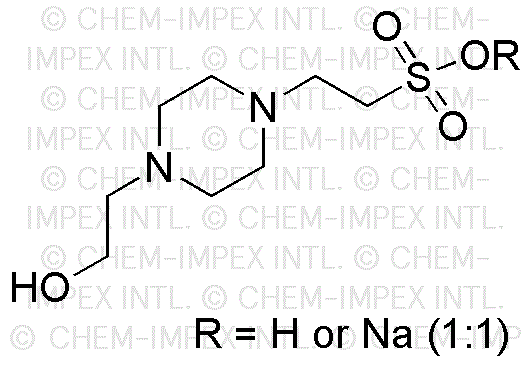4-(2-Hydroxyethyl)-1-piperazineethanesulfonic acid hemisodium salt is widely utilized in research focused on:
- Biological Buffers: This compound serves as an effective buffering agent in biological and biochemical research, maintaining pH stability in various experiments.
- Cell Culture Media: It is commonly used in cell culture media formulations, providing an optimal environment for cell growth and maintenance.
- Pharmaceutical Development: The compound plays a crucial role in drug formulation, enhancing the solubility and stability of active pharmaceutical ingredients.
- Protein Purification: Its unique properties aid in the purification processes of proteins, making it valuable in biochemistry and molecular biology labs.
- Diagnostic Reagents: This chemical is utilized in the preparation of diagnostic reagents, contributing to the accuracy and reliability of various analytical tests.
General Information
Properties
Safety and Regulations
Applications
4-(2-Hydroxyethyl)-1-piperazineethanesulfonic acid hemisodium salt is widely utilized in research focused on:
- Biological Buffers: This compound serves as an effective buffering agent in biological and biochemical research, maintaining pH stability in various experiments.
- Cell Culture Media: It is commonly used in cell culture media formulations, providing an optimal environment for cell growth and maintenance.
- Pharmaceutical Development: The compound plays a crucial role in drug formulation, enhancing the solubility and stability of active pharmaceutical ingredients.
- Protein Purification: Its unique properties aid in the purification processes of proteins, making it valuable in biochemistry and molecular biology labs.
- Diagnostic Reagents: This chemical is utilized in the preparation of diagnostic reagents, contributing to the accuracy and reliability of various analytical tests.
Documents
Safety Data Sheets (SDS)
The SDS provides comprehensive safety information on handling, storage, and disposal of the product.
Product Specification (PS)
The PS provides a comprehensive breakdown of the product’s properties, including chemical composition, physical state, purity, and storage requirements. It also details acceptable quality ranges and the product's intended applications.
Certificates of Analysis (COA)
Search for Certificates of Analysis (COA) by entering the products Lot Number. Lot and Batch Numbers can be found on a product’s label following the words ‘Lot’ or ‘Batch’.
*Catalog Number
*Lot Number
Certificates Of Origin (COO)
This COO confirms the country where the product was manufactured, and also details the materials and components used in it and whether it is derived from natural, synthetic, or other specific sources. This certificate may be required for customs, trade, and regulatory compliance.
*Catalog Number
*Lot Number
Safety Data Sheets (SDS)
The SDS provides comprehensive safety information on handling, storage, and disposal of the product.
DownloadProduct Specification (PS)
The PS provides a comprehensive breakdown of the product’s properties, including chemical composition, physical state, purity, and storage requirements. It also details acceptable quality ranges and the product's intended applications.
DownloadCertificates of Analysis (COA)
Search for Certificates of Analysis (COA) by entering the products Lot Number. Lot and Batch Numbers can be found on a product’s label following the words ‘Lot’ or ‘Batch’.
*Catalog Number
*Lot Number
Certificates Of Origin (COO)
This COO confirms the country where the product was manufactured, and also details the materials and components used in it and whether it is derived from natural, synthetic, or other specific sources. This certificate may be required for customs, trade, and regulatory compliance.


